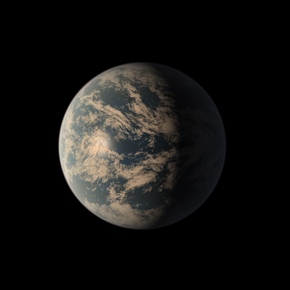
Back ترابيست-1d Arabic TRAPPIST-1d Bulgarian TRAPPIST-1d Catalan Trappist-1 d German TRAPPIST-1d Greek TRAPPIST-1d Spanish تراپیست-۱دی Persian TRAPPIST-1 d French TRAPPIST-1 d Hungarian TRAPPIST-1d ID
 Artist's impression of TRAPPIST-1d (February 2018). | |
| Discovery[1] | |
|---|---|
| Discovered by | Michaël Gillon et al. |
| Discovery site | TRAPPIST |
| Discovery date | May 2, 2016 |
| Transit | |
| Orbital characteristics[2] | |
| 0.02227±0.00019 AU | |
| Eccentricity | 0.00837±0.00093[3] |
| 4.049219±0.000026 d | |
| Inclination | 89.896°±0.077° |
| −8.73°±6.17°[3] | |
| Star | TRAPPIST-1[4] |
| Physical characteristics[2] | |
| 0.788+0.011 −0.010 R🜨 | |
| Mass | 0.388±0.012 M🜨 |
Mean density | 4.354+0.156 −0.163 g/cm3 |
| 0.624±0.019 g 6.11±0.19 m/s2 | |
| Temperature | Teq: 286.2±2.8 K (13.1 °C; 55.5 °F)[5] |
TRAPPIST-1d, is a small exoplanet (about 40 percent the mass of the Earth), which orbits on the inner edge of the habitable zone of the ultracool dwarf star TRAPPIST-1, located 40.7 light-years (12.5 parsecs) away from Earth in the constellation of Aquarius. The exoplanet was found by using the transit method. The first signs of the planet were announced in 2016, but it was not until the following years that more information concerning the probable nature of the planet was obtained. TRAPPIST-1d is the second-least massive planet of the system and is likely to have a compact hydrogen-poor atmosphere similar to Venus, Earth, or Mars.[6] It receives just 4.3% more sunlight than Earth, placing it on the inner edge of the habitable zone.[7] It has about <5% of its mass as a volatile layer, which could consist of atmosphere, oceans, and/or ice layers.[3] A 2018 study by the University of Washington concluded that TRAPPIST-1d might be a Venus-like exoplanet with an uninhabitable atmosphere.[8] The planet is an eyeball planet candidate.[9]
- ^ Cite error: The named reference
Gillon2016was invoked but never defined (see the help page). - ^ a b Cite error: The named reference
Agol2021was invoked but never defined (see the help page). - ^ a b c Cite error: The named reference
Grimm2018was invoked but never defined (see the help page). - ^ Cite error: The named reference
vangrootel2017was invoked but never defined (see the help page). - ^ Cite error: The named reference
Ducrot2020was invoked but never defined (see the help page). - ^ February 2018, Elizabeth Howell 07 (7 February 2018). "Rocky-Planet-Like Atmospheres Are Possible on 3 TRAPPIST-1 Planets". Space.com. Retrieved 10 February 2021.
{{cite web}}: CS1 maint: numeric names: authors list (link) - ^ Cite error: The named reference
Delrez2018was invoked but never defined (see the help page). - ^ Cite error: The named reference
eurekalert.orgwas invoked but never defined (see the help page). - ^ Anders, Charlie Jane (13 February 2019). "The Bizarre Planets That Could Be Humanity's New Homes". The Atlantic. Retrieved 10 February 2021.
© MMXXIII Rich X Search. We shall prevail. All rights reserved. Rich X Search